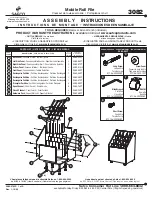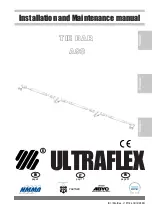
7
• Leave FOR/OFF/REV switch in FOR (forward)
position.
• Push down on clutch handle to engage cable.
With mitted hand pull cable out of line (if possible)
or hold cable against edge of inlet to thread the
cable out until loop forms in front of the machine.
NOTE! By holding the cable against the edge of
the inlet, in the FOR (FORWARD) position, the
rotation
will rapidly “thread” the cable out of the
line.
• When loop forms, release clutch handle and
push excess cable back through machine.
Disconnect one section at a time. When
disconnecting sections, remember to turn unit off
and secure cable in line.
• Once section of cable is removed, insert the
secured cable in through the front of the
machine and continue removing sections until
tool on last section of cable is just inside sewer
inlet. Never retract tool from sewer inlet while
cable is rotating. Tool can whip causing serious
injury.
12. Turn FOR/OFF/REV Switch to OFF position.
13. Pull remaining cable and tool from sewer.
After using, thoroughly flush and drain cables,
couplings and tools with water due to damaging
effects of some drain cleaning compounds.
Cleaning Drain Using 5/16
″Cable Adapter
(optional)
1. Assume the correct operating posture in order
to maintain proper balance.
Should an unexpected situation arise, this
posture provides you with the opportunity to
safely keep control of the machine and cable.
• Be sure you can quickly release the clutch
handle.
• Hand must be on the cable to control its
twisting action when it hits an obstruction.
• Must have access to FOR/OFF/REVERSE
switch.
2. Pull out enough cable by hand to insert into
the drain opening and hand-feed the cable into
drain until it stops feeding easily. Push cable
down drain line
keeping your control hand close to the drain
opening.
3. Hold cable loosely in mittened hand, put
FOR/OFF/REV SWITCH in FOR (forward)
position.
NOTE! The motor will start but cable will not
rotate.
4. With mitted hand on cable, push down on
clutch handle with opposite hand to engage
adapter.
5. Continue hand-feeding the cable slowly until
the drain is opened or blockage is encountered.
Keep your cable hand close to the drain opening
to keep control of the cable and help prevent
cable flip-over.
6. When you reach the blockage, work the cable
back and forth to clear the obstruction. At this
point, progress depends on the type of tool being
used and nature of the blockage. Advance cable
slowly.
7. If cable gets hung up in the obstruction,
release the clutch handle to stop the rotation of
the cable. Refer
to “Reverse Operation” in the
“Special Procedures” section.
8.
Once
obstruction
is
cleared,
it
is
recommended that operator flush debris from
line with running water.
Repeat Step 6 several times if necessary for
thorough cleaning job and then work cable
through additional stoppages as required. Cable
is not attached inside drum. When approaching
end of cable, keep hand securely on cable to
avoid losing it down the drain.
9. To withdraw cable from line with machine
running, leave FOR/REV lever in FORWARD
position and slowly pull cable from drain.
10. As excess cable is retrieved from line,
hand-feed cable back into A150.
11. Release clutch handle just prior to cable or
tool emerging from drain opening. Cable or tool
may contain debris and splash work area. Never
retract tool from sewer inlet while cable is
rotating. Tool can whip causing serious injury.



























